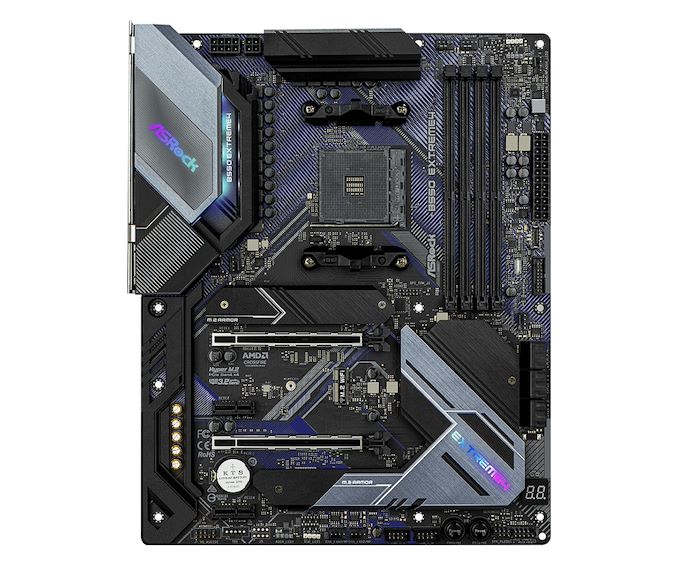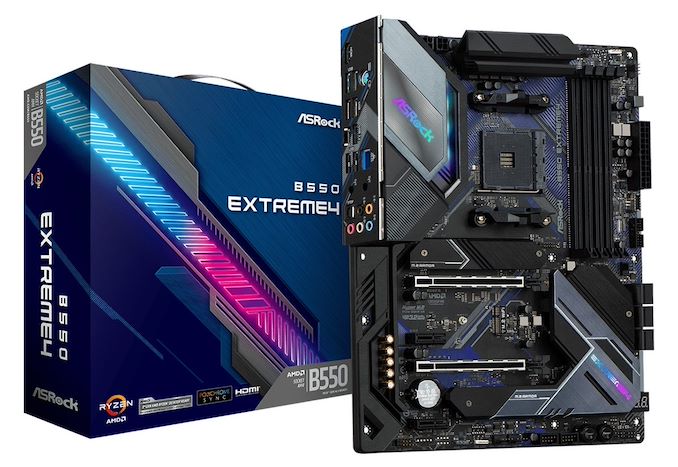The AMD B550 Motherboard Overview: ASUS, GIGABYTE, MSI, ASRock, and Others
by Dr. Ian Cutress & Gavin Bonshor on June 16, 2020 11:00 AM ESTASRock B550 Extreme4
The ASRock B550 Extreme4 was one of the motherboards highlighted at the beginning of this article as one to look out for. We picked this one out not so much for the hardware or the price, but because of the styling. ASRock has had the Extreme line of motherboards for longer than I’ve been testing motherboards, but with this generation it seems to have had a very striking visual update. We now have an epic blue streak morphing into purple across the box, the heatsinks, and even the PCB. I think it looks neat. Ian
This is another board showing a 45-degree diagonal left-to-right downward slope, but this time ASRock has added a bit more color to the system. There are some LEDs on here, most noticeably on that power delivery heatsink on the top left, next to the IO shield, but the design here seems very visually clear.
As for features, the socket is powered by an 8-pin and a 4-pin, and while the power delivery heatsinks are not connected via a heatpipe, the appear to be substantial enough for the builds this board should be going into. The socket has access to five 4-pin fan headers in easy reach, and next to the socket are the four DRAM slots, using single sided latch designs.
On the right hand side we have RGB LED headers, a 24-pin ATX connector, a Type-C header, a USB 3.0 header, six SATA ports, a two-digit debug display, and power/reset buttons. Along the bottom is another RGB LED header, two more fan headers, two USB 2.0 headers, and front panel connectors.
The PCIe area has a PCIe 4.0 x4 M.2 slot at the top, connected via the CPU, but also with its own heatsink on top. Beneath this is a full-length reinforced PCIe 4.0 x16 slot, and the next full-length slot is a reinforced PCIe 3.0 x4 design. The bottom M.2, a PCIe 3.0 x2, has a heatsink connected to the chipset heatsink. On the left is the upgraded Realtek ALC1220 audio, which also uses an NE5532 amp.
The rear IO panel starts with a HDMI output, a combination PS/2 connector, two USB 3.2 Gen 1 ports, four USB 2.0 ports, a Type-A USB 3.2 Gen 2 port, a Type-C USB 3.2 Gen 2 port, a Realtek RTL8125GB 2.5 gigabit Ethernet port, a space for Wi-Fi antenna, and the audio jacks.













101 Comments
View All Comments
Operandi - Tuesday, June 16, 2020 - link
Looks like some nice mATX versions this round, nice!YB1064 - Thursday, June 18, 2020 - link
I was hoping to see a $75-$90 board.kenjiwing - Tuesday, June 16, 2020 - link
Fortunately, this component is a unique motherboard among B550 and well worth reading up on [add link].Needs to be edited.
anirudhs - Tuesday, June 16, 2020 - link
There's a noise sensor which can adjust fan speed for maximum quietness with good thermals. Saw it on the KitGuruTech video. The noise sensor isn't there to spy on you though.PeterCollier - Wednesday, June 17, 2020 - link
The quality of the editing here is shit tier. Seriously, just run the articles through Grammarly before publication. It's free and it spots plenty of errors.Heavenly71 - Tuesday, June 16, 2020 - link
Sadly none of the mITX boards have more than 6 external USB ports. My old ASUS mITX has 8! And in really small mITX cases you can't add a bracket with more USB, because the two brackets are already used by the gfx card. Guess I have to wait for an enthusiast mITX board )-:damianrobertjones - Tuesday, June 16, 2020 - link
Or, just maybe, get a usb dongle with 4 ports?Mr Perfect - Tuesday, June 16, 2020 - link
That is disappointing. The number of USB devices people need to plug in can't be dropping, surely? I know I've got more now then even a year ago.rrinker - Tuesday, June 16, 2020 - link
Are they really going up? I have 2 USB devices plugged in to my system - a keyboard and a mouse. I occasionally plug a USB stick in one of the front ports to transfer files. My phone and tablet sync over wifi, they don't get plugged in. I have a charger behind my desk and a cable to charge them. My printer is on the network.The one place I DO need lots of USB ports is also the place where I have a small cube case machine, with no discreete GPU, because it doesn;t need one. On that one I added a USB PCI card to get enough ports. In addition to the keyboard and mouse, that machine is on my workbench where it connects to several electronic test instruments and I have multiple cabled for programming microcontrollers. I also have a USB microscope for board inspection. And then I have 3 more USB devices connected for my other hobby that shares the bench. Plus a front port kept free for USB sticks.
So the use case I have for more USB has the PCI slots open to add expansion cards, the use case where I have a discrete GPU eating up the slot space doesn't need an excess of USB ports.
DigitalFreak - Tuesday, June 16, 2020 - link
I use 3 USB 3.0 ports just for my Oculus Rift